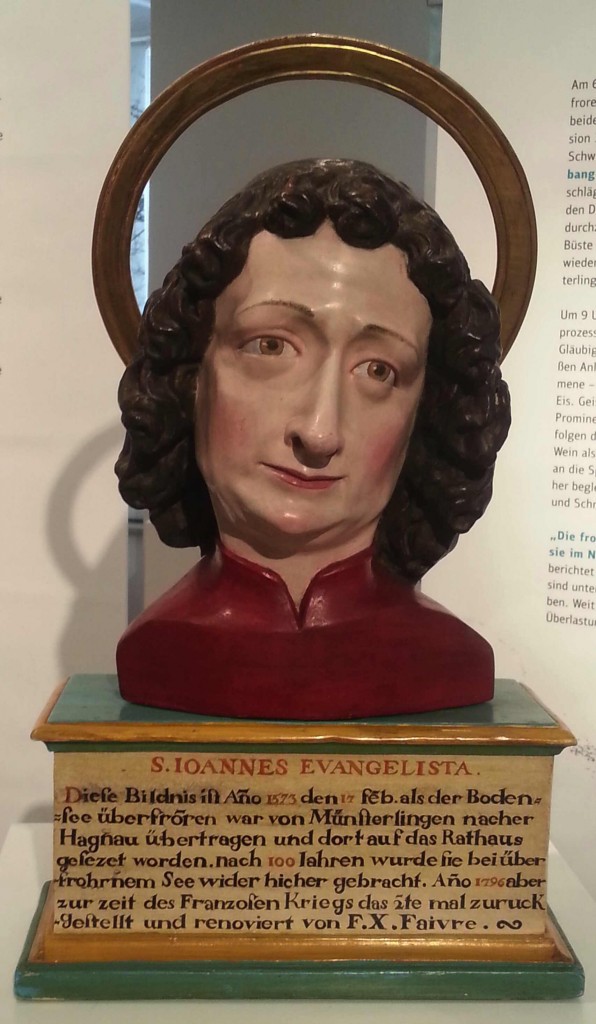The English are internationally famed for talking about the weather. Personally, I think this is the effect of English politeness: one isn’t supposed to talk about religion, politics or money, the weather is all that is left to us. But the weather in the British Isles is remarkably varied, and, as has become all too obvious, can be appalling. But however much water has fallen from the sky in the past month or so, it has been remarkably mild. The same cannot be said of the winter of 1962-63, famed for its heavy snows (and a corresponding boom in the birth rate in the following autumn). But if we thought it was bad in England, it was worse on the continent: around Lake Constance in South West Germany (the Bodensee to the locals) the temperature was below zero from November to March, and in February it settled around -22°C. So cold, in fact, and for so long, that the lake froze over.
It wasn’t the first time that this had happened: the earliest recorded occurrence was in 875, by which time Benedictines had settled on what was (usually) the relatively inaccessible island of Reichenau, further west, on another part of the lake. Seegefrörni – the local dialect word (plural) for the freezing of the lake – gradually increased in frequency, peaking in the 15th and 16th centuries: the lake froze over seven times in each of these centuries. At some point – and nobody is entirely sure when – a curious tradition developed: a relic of St John the Evangelist was taken over the ice from one side of the lake to the other.

St John the Evangelist, attributed to Jakob Russ, early 16th Century. By now, the reliquary is back in Switzerland in the Abbey Church of Münsterlingen. The abbey closed long ago: its buildings now house one of Switzerland’s major psychiatric hospitals.
In the early 16th century a reliquary bust was carved and painted to contain a bone of Jesus’s favourite disciple. It is attributed to Jakob Russ, a sculptor active in Ravensburg, less than 30km from Hagnau on the Bodensee, one of the relic’s homes. Like the work of other Northern European painters and sculptors – think of Rogier van der Weyden or Tilman Riemenschneider (and if you don’t know his work, look him up!) – Russ is not happy to settle with the generic idealised faces so favoured by the Italians, who portrayed their holy subjects with an almost geometric perfection. He modulates every surface, giving the sense that the face was modelled in clay rather than carved in wood. He’s not a pretty boy, and would never be confused – as Dan Brown notoriously did – for Mary Magdalene. His intense presence, with a repressed sorrow in the eyes, suggests that Russ was imagining a detail from the crucifixion, and John’s suffering vigil at Christ’s left hand.
The first recorded example of the procession took place exactly 441 years ago, on 17 February 1573, although the tradition may well have begun earlier. The reliquary bust was carried in procession from Münsterlingen, on the Swiss side of the lake, to Hagnau, on the German side, accompanied by 100 people. The event is recorded on the base of the reliquary bust, although the inscription is far more recent, including, as it does, a reference to another ‘translation’ of the relic during the French War of 1796 (think Napoleon), when it was restored by F.X. Faivre. On the back (not illustrated!) it also mentions the procession of 1830. Although there was a seegefrörne in 1880 the ice was not hard enough – or thick enough – to warrant a procession.
The last procession took place just over 51 years ago, on 12 February 1963, and news even reached the British press. A report was published in The Sphere (an illustrated weekly newspaper published between 1900 and 1964) on 2 March. There was no Twitter then, and news could take two whole weeks. Rather than the 100 faithful who followed the procession back in 1573, this time there were over 3000: a contemporary photograph shows them winding away into the distance, leaving the German shore of the lake to walk a 9km route across the ice. Borne aloft on the shoulders of two of the faithful, the relic has remained in Switzerland ever since: with climate change who knows when the lake will ever freeze again?
I had been wanting to see this relic of an ancient tradition ever since I first visited the Bodensee three years ago, and finally made a pilgrimage to Münsterlingen last month. It wasn’t there. It seems that, with climate change, the locals have given up on the possibility of another seegefrörne, and to mark the 50th anniversary of its last translation, the relic had been taken around the lake by road. Or maybe it crossed on one of the two regular ferries that transport modern traffic 24/7 (even they had to stop in 1963). So last week, I went to Hagnau, where I finally found it, boldly eyeballing the visitors to its own exhibition.
I can’t help thinking the locals are being a little impatient – I mean, fifty years? It’s not that long. It was 113 years between the last two seegefrörni, so there’s a while to go yet. And ‘climate change’ does not have the same implication as ‘global warming’. One impact is likely to be an increase of more extreme weather events, and that could include more winter snow and extremely low temperatures. I’d start stocking up on jumpers now if I were you.



